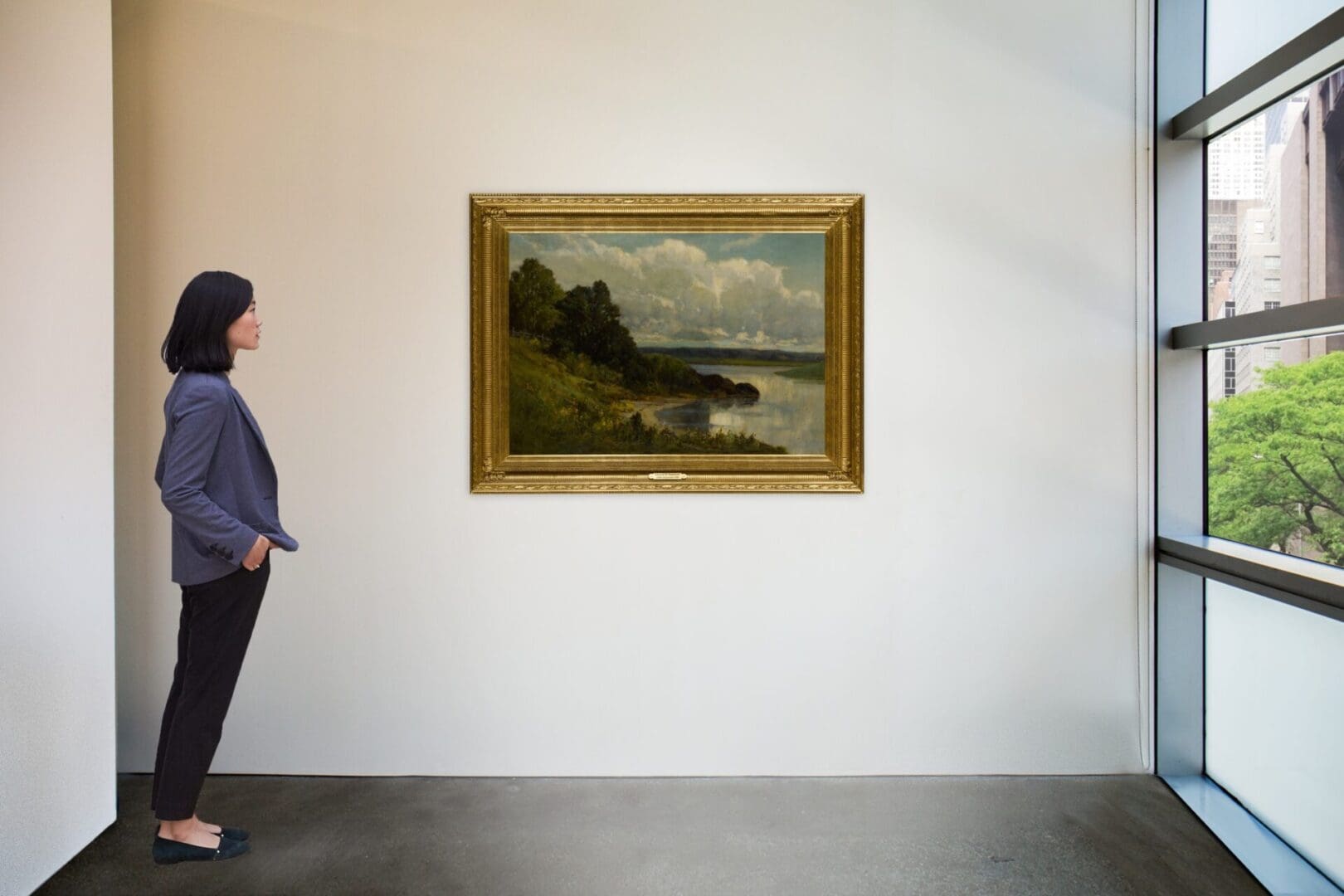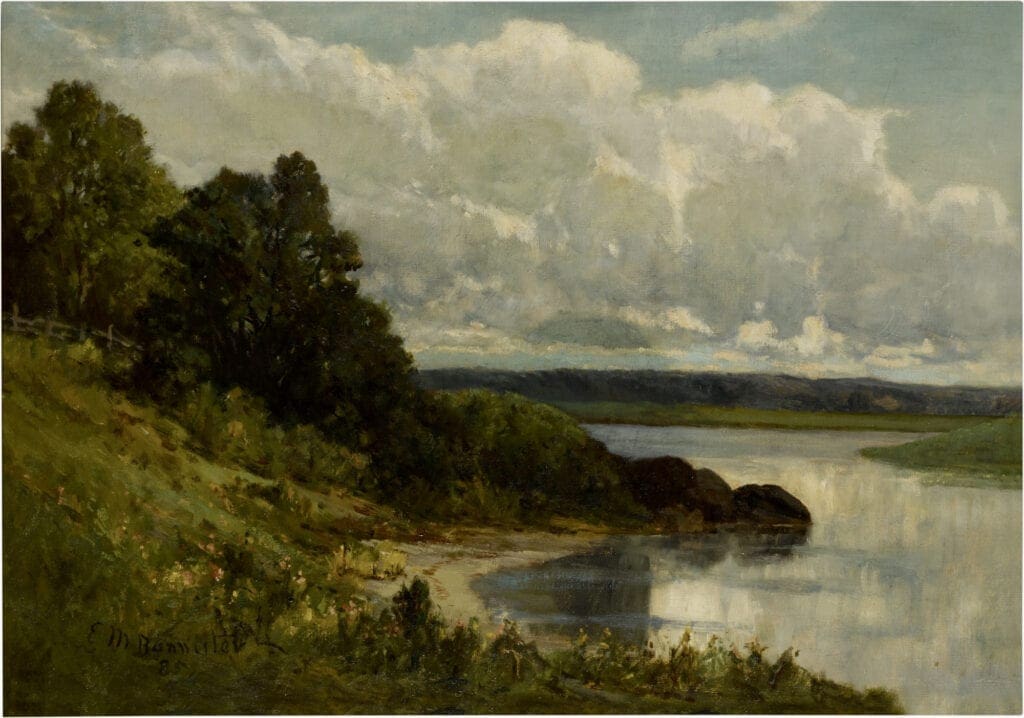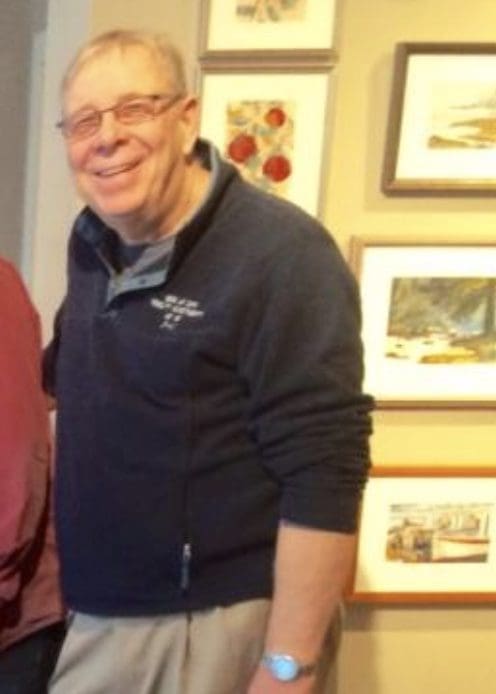Search Posts
Recent Posts
- Rhode Island Weather for June 18, 2025 – Jack Donnelly June 18, 2025
- Johnson & Wales University names Joseph Greene, Providence campus president, to lead major new initiatives June 18, 2025
- To Do in RI: Hospitality employees and Newport Co. residents welcome at free Newport attractions June 18, 2025
- Time for Sour Grapes – June 18, 2025 – with Tim Jones June 18, 2025
- It is what it is: Commentary, 6.18.25 – with Jen Brien June 18, 2025
Categories
Subscribe!
Thanks for subscribing! Please check your email for further instructions.

Edward Bannister painting from “prominent Rhode Islander” sets record at Sotheby’s auction
Valued to be sold at auction between $50 and $70,000, “Palmer River”, an 1885 painting by Edward M. Bannister sold for $220,000 ($277,200 with buyer’s premium) to an undisclosed bidder at Sotheby’s.

In a conversation with the seller, former Providence Art Club President, Dan Mechnig, who spoke most enthusiastically about the painting and also the effort to put a life-size statue of Bannister somewhere in Providence, Mechnig noted Bannister was one of the two original founders of the Providence Art Club (along with George Whittaker).
Bannister was also the first African-American to take first place, winning the Centennial Gold Medal for a painting, “Under The Oaks”, at the Philadelphia Centennial Exposition, making him one of the best-known painters in New England and the first African-American artist to win widespread notoriety. The interesting thing was that the exhibition judges did not know that Bannister was black and scrambled a bit after they learned this to make sure that their decision was correct. The year was 1876 and only a short time, relatively, from the Amancipation Proclamation. Bannister died in 1901, and in that year, the Providence Art Club did The Memorial Exhibition which included 101 of Bannister’s paintings, with numerous paintings being loaned from the private collection of many artists of the day, including George Whitaker, who loaned five large scale canvases to the exhibit.

Mechnig is a true lover of art and wanted to determine the painting’s fate. As he said, “being in my 70s, I thought this was the time”.
The painting will be included in the forthcoming Edward Mitchell Bannister Catalogue Raisonné. Sotheby’s worked with Anne Louise Avery, author of the Edward Mitchell Bannister: Catalogue Raisonné in cataloguing this lot. A catalogue raisonné is a comprehensive, annotated listing of all the known works of an artist either in a particular medium or all media.
“Ultimately, any study of the art and the artist must encompass the man. . . Bannister believed that art was a moral power, and his identity as an African American merged with his delight in knowledge and his love of art as a power for good.” – (Juanita Marie Holland, Edward Mitchell Bannister 1828-1901, New York, 1992, p. 57
Daniel Mechnig
For the Sotheby’s auction, they had documented the painting’s Provenance and Exhibit history. As Mechnig noted, it is not that often that a painting of such prominence has such a documentation that follows the history and exhibition resume in such a complete way.
Provenance –
Scott A. Smith, by 1901
Scott A. Smith Family Collection (by descent)
Joseph K. & Anne Ott, Providence, Rhode Island, circa 1960s
Acquired by the present owner from the above, 1985
Literature –
“19th Century African American Artists of the North and West,” The International Review of African American Art, Hampton, Virginia, January 1995, vol. 12, no. 1, p. 1, illustrated
Exhibited –
Providence, Rhode Island, Providence Art Club, Bannister Memorial Exhibition, January 1901
San Francisco, California, The Art Museum Association of America in California, Hidden Heritage: The Art of Black America 1800-1950, 1985-1990, no. 16
Providence, Rhode Island, Providence Art Club & Newport, Rhode Island, Newport Art Museum, Edward M. Bannister Exhibition, 1990-1991
New York, Kenkeleba House; Stamford, Connecticut, Whitney Museum of American Art at Champion, Edward Mitchell Bannister 1828-1901, May 1992-January 1993, p. 31
Providence, Rhode Island, Providence Art Club, Edward Mitchell Bannister, May-June 1997
Newport, Rhode Island, Roger King Gallery of Fine Art; New York, Kenkeleba House, Edward M. Bannister: A Centennial Retrospective, October 2001-February 2002, p. 14
Newport, Rhode Island, Newport Art Museum, Barbizon to Impressionism Exhibit, October 2007-January 2008
Nantucket, Massachusetts, Museum of African American History Boston and Nantucket; Boston, Massachusetts, Federal Reserve Bank, Black Entrepreneurs of the Eighteenth and Nineteenth Centuries, May 2009-February 2010, p. 9
Providence, Rhode Island, Providence Art Club, Our Founders, 2010
Boston, Massachusetts, McMullen Museum of Art, Mapping Realism: Paintings from the Royal Museum of Fine Arts of Belgium and American Collections, September-December 2013,no. 48, p. 133, illustrated
Saunderstown, Rhode Island, Gilbert Stuart Museum, Edward Mitchell Bannister, June-October 2018
Who was Bannister?

Edward Mitchell Bannister was born in New Brunswick, Canada, circa 1828. After working on trading ships in the Northeast, he moved to Boston with his brother by 1850. Census records confirm they were employed as hairdressers and Bannister simultaneously pursued ambitions to become an artist. It was in 1854 that he was awarded his first commission by Dr. John V. DeGrasse, a leading member of the Boston’s Black community. The collective of flourishing African American artists he joined there played a significant role in nurturing Bannister’s development as a working artist. During his formative years in Boston he was denied access by the established, predominantly White, arts community to basic training, educational apprenticeships and European travel. For Bannister and many African American communities living in the Northeast during the period following the Civil War, freedom was realized only in part–they still lived in a society segregated by Jim Crow laws and witnessed the horrific reality of the Fugitive Slave Act of 1850. Juanita Marie Holland writes, and as evidenced by Bannister’s accomplishments during this period, “The pursuit of excellence became a means by which to hold back the deluge of racial stereotypes in literature and art” (Juanita Marie Holland, Edward Mitchell Bannister 1828-1901, New York, 1992, p. 21).
The start of the following decade marked advancements for Bannister and his entrance into the White arts community in Boston. In 1863 he began formal training under Dr. William Rimmer, a local physician and sculptor, who admitted Bannister as the only African American student to his evening drawing classes. Then in October of 1969 Bannister and his wife moved to Providence, Rhode Island, where he again found a thriving community of African American artists whose leaders welcomed him as an already established talent. By 1872 he took a studio at the Woods Building and worked there for the remainder of his career. He began to exhibit his work more frequently in Providence and continued to submit works to be considered for exhibition at the Boston Arts Club. The awards and accolades bestowed upon Bannister’s work during this prolific period were assigned based upon the aesthetic achievements illustrated in his paintings. Bannister’s race, however, was prejudicial. He was acutely aware of this dynamic and intentionally submitted the painting Under The Oaks (unlocated) to the Philadelphia Centennial Exposition of 1876 with just a signature and no further identifying information about the artist. Bannister explained this decision saying, “I was not an artist to them, simply an inquisitive colored man” (ibid, p. 34). He later discovered in the newspaper that his painting, only recorded as number fifty-four on the exhibition checklist, had won first prize. Bannister told the Chicago Times in 1895, “I was and am proud to know that the jury of award did not know anything about me, my antecedents, color or race. There was no sentimental sympathy leading to the award of the medal” (ibid, p . 25).
The limited number of works that have been located and accurately attributed to Bannister, many of them landscape subjects, reflect a broad range of stylistic influences. As Holland explains, “Experimentation was clearly part of a lifelong process of artistic education for Bannister, and he seems to have easily quoted different styles as they suited his vision for a particular work” (ibid, p. 34). In discussing The Palmer River she notes Bannisters “affinity for free and lushly rendered surfaces” (bid). She concludes, “Although Bannister has until now been viewed primarily as a Barbizon-influenced painter of pastoral landscapes . . . the range of his artistic production indicates more varied thematic and stylistic concerns . . . A strong sense of compositional design endowed his paintings with a charged stillness of tremendous energy, and his best works combine a tactile exploration of painting with a reverent and poetic sensibility. He was a painter whose powerful spiritual convictions infused his views of nature with a pantheistic celebration of what he defined as the ‘infinite, subtle qualities of the spiritual idea, centering in all created things. . . .’”
As demand for his work grew, Bannister’s position among the Providence art society was cemented. In 1878, while serving on the board of the Rhode Island School of Design, he joined George Whitaker and Charles Walter Stetson in founding what would later become the Providence Art Club. The charter became a fundamental organization dedicated to the preservation and promotion of their burgeoning arts community. Through the 1880s though, many of the established artistic institutions in America were still marred with conflicting business and political interests which did not always afford Bannister and other African Americans the equity they so deserved among their artistic peers. After the largest exhibition of Bannister’s works during his lifetime had been mounted at the Providence Art Club in 1891, his friend George Whitaker offered the following reflection, “Is it right that a man of such power should be allowed to slip through our community without due recognition?” (ibid, p. 53).
Whitaker’s commitment to ensuring Bannister’s legacy began with a retrospective exhibition featuring more than 100 of the artist’s works, lent by prominent private collectors and patrons, at the Providence Art Club the year he died in 1901. Decades later Bannister was posthumously inducted into the Rhode Island Heritage Hall of Fame and Rhode Island College established the Bannister Gallery in his honor in 1978. In 2017, more than a century after his death, the Providence City Council voted to rename Magee Street, formerly named after a prominent Rhode Island slave trader, to Bannister Street in memory of the significant contributions Bannister and his wife Christiana made toward bettering their community for its disenfranchised Black members. Holland concludes, “Ultimately, any study of the art and the artist must encompass the man. . . Bannister believed that art was a moral power, and his identity as an African American merged with his delight in knowledge and his love of art as a power for good” (ibid, p. 57)
_____
“Bannister often struggled to translate his vision of nature into paint – he was extremely self-critical, discarding works when they fell short of his high standards, once even famously using a painting to shovel ash. When his creativity, aesthetic philosophy and artistic skill conflated to his own satisfaction, however, as here in Palmer River, his painting soars, offering one of the most complex and beautiful envisionings of the American pastoral in the late 19th century.” – Anne Louise Avery, Author of ‘Edward Mitchell Bannister: Catalogue Raisonné’
As Mechnig noted, “one can imagine Bannister going out to The Palmer River to get inspiration for his painting”.
The Palmer River, named for Walter Palmer, one of the founders of Rehoboth, MA, is an 11 mile river with tributaries and brooks beginning in Rehoboth, with a Rhode Island tributary in Barrington, and meets with The Warren River.
